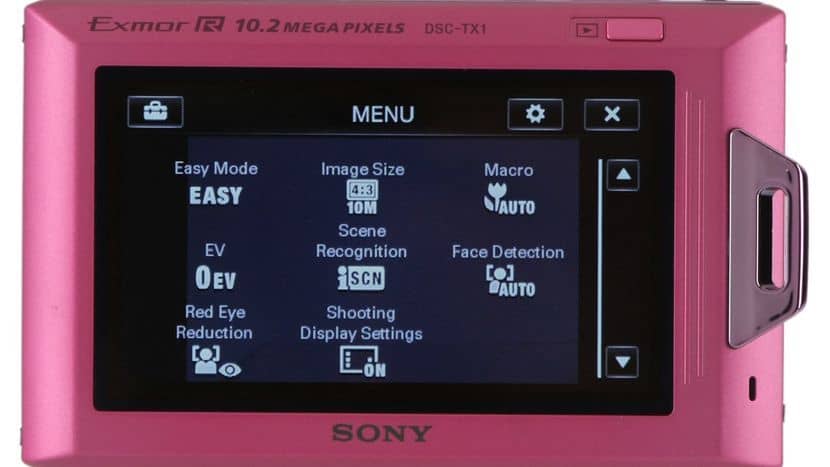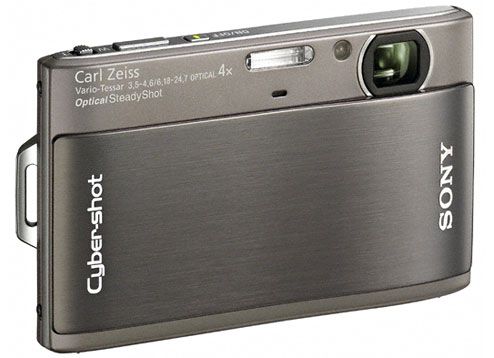Table of Contents
amazon Sony TX1 reviews
The highlight of TX1 is the compact size of the product. The body is only 16.5 mm thick and weighs less than 140 grams, ideal for put in a shirt pocket. The front slightly bulb slightly to help avoid slipping when the hands out too much sweat while increasing the aesthetic value. The thin outer shell works to protect the lens. This is also a very interesting feature inherited from the “senior” T700 and T90, making the boot operation more flexible and faster.
The TX1’s control system is simplified with the help of a 3-inch, 230,000-dot touchscreen. The top of the TX1 only has power on / off, capture keys and a zoom dial. Clear Photo Plus technology enables users to view photos directly in different lighting conditions without fear of glare or color defects. The icons on the screen are arranged quite orderly and easy to understand with clear notes. According to the Imaging Resource, the TX1 interface can be listed as one of the nicest and simplest among the compacts available today. The high-sensitivity multi-touch screen makes sliding and selection very smooth.
The TX1’s Exmor R 10.1 Megapixel CMOS sensor uses Sony’s back-lit technology, which was heavily advertised at the 2009 PMA. The company claims that the Exmor R sensor is twice as sensitive as its predecessor. Use traditional FSI technology. Experiments by the Imaging Resource and Photographyblog show that, at ISO 125 and 200, the details show quite well even in areas with high contrast. The image is a little fuzzy but does not affect much when it comes to medium size printing. The noise is still well controlled at ISO 400. The ISO settings are higher than 800, which results in significant loss of detail and dullness.
The Sony TX1 uses a Carl Zeiss Vario-Tessar lens, which consists of 12 components divided into 10 groups, including four aspherical lenses and a photo prism. The focal range of the machine ranges from 35 mm to 140 mm (equivalent to a film camera), equivalent to a 4x zoom. The maximum aperture of the camera is only f / 3.5, which is a bit inconvenient in under-exposed shots, and detract from the Exmor R’s superiority. The TX1 is too small and deep inside the body. The image is quite faint at the edges. The blurring area appears most clearly at the bottom left edge. Image distortion also appears to be slightly above average when the lens is at the lowest focal length of 35 mm. In contrast, chromatic aberration on high contrast areas is well handled. The TX1 also has an optical anti-shake mechanism, which improves the exposure time by 2.5 to 4 stops from normal without blurring.
Sony TX1 has up to 7 wearing scenes for the user to choose from. Intelligent Auto mode can identify up to 9 types of scenes with lighting conditions and faces within 1/30 of a second. This mode also allows the user to customize at full automatic or advanced level.
where can you get a Sony TX1 online
Sony Cyber-shot DSC-TX1 10MP “Exmor R” CMOS Digital Camera with 3-inch Touch-Screen LCD (Silver): Buy it now
Sony Cyber-shot DSC-TX1/H 10MP “Exmor R” CMOS Digital Camera with 3-inch Touch-Screen LCD (Grey): Buy it now
Sony Cyber-shot DSC-TX1/P 10MP “Exmor R” CMOS Digital Camera with 3-inch Touch-Screen LCD (Pink): Buy it now
Sony Cyber-shot DSC-TX1/L 10MP “Exmor R” CMOS Digital Camera with 3-inch Touch-Screen LCD (Blue): Buy it now
Sony Cyber-shot DSC-TX1 (Gold) Digital Camera: Buy it now
The camera also supports shooting in low light conditions with the Handheld Twilight function. It will shoot 6 consecutive images at high speed (less than 1 second) when you press the shutter button only once. The images will be transferred to the Bionz processor for analysis, removing noise and blurring around the subject, eventually producing a complete single image. The images are a bit blurry, but they have very little noise and high contrast even with ISO up to 1,600. At this level of sensitivity, most travel cameras on the market today are not capable of reproducing full details and standard color areas such as the TX1. Continuous anti-blur shooting features are similar to the Handheld Twilight function, but are optimized to produce.
For casual users, Panorama panning function is an interesting “gift” that Sony favor TX1. Instead of having to take a picture and then pair it on the computer, you just press the shutter button once, pan the camera at moderate speed and wait for TX1 to process the data. The output image can reach a maximum resolution of 4,912 x 1,080 pixels, just the size of an HDTV screen.
TX1 is quite fast. The shutter lag is only about 8 milliseconds, up to 0.6 second when the lens is not focused on the subject. In single shooting mode, the camera has about 1.4 frames per second. Continuous shooting speed at the highest setting can reach 10 frames per second. The standby time between the two images when the flash is set at the strongest power is only about 4 seconds, very impressive with a “thin” model as TX1. The white balance of the camera tends to be slightly warm when taken under the incandescent light. When manually switched to Manual WB, this phenomenon is completely eliminated.
Although there are some disadvantages due to the limitations of the lens, but overall, TX1 is a perfect travel camera with rich feature set, fashion design without sacrificing image quality.

